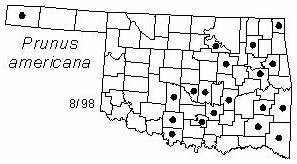Thicket-forming shrub or tree to 11 m (35 ft) tall. Crown spreading. Bark dark brown to red-brown, platy. Twigs green to red-brown with minute lenticels, glabrous. Leaves alternate, simple; ovate, obovate, or oblong, 6.4-10 cm (2.5-4 in) long and 3.8-5 cm (1.5-2 in) wide, glabrous, although may be slightly pubescent along the veins beneath; dark green above, paler beneath; rounded or cuneate at base; acuminate at apex; margins singly or doubly serrate; petioles 12-20 mm (0.5-0.75 in), long and slender, glabrous or somewhat pubescent. Flowers in umbels, 2-5 flowers on slender glabrous pedicels; calyx-tube obconic, 5-lobed, glabrous or pubescent; petals 5, white; styles 1; stamens 20; flowers appear from March to May. Fruits drupes, 20-25 mm (0.75-1 in) in diameter, subglobose, red, glaucous; fruits mature in June to July.
Distribution: Oklahoma, Texas, New Mexico, and Arkansas, Rocky Mountains, to southern Ontario, east to Massachusetts, south to Florida. Common in Oklahoma.
Habitat: moist woods, fencerows and roadsides.
NWI status: UPL, FACU.
Comments: Prunus is the classical name for European plums. The thicket-forming proclivity of plum species was reported by George Catlin in 1837 as he passed through southern Oklahoma along the Red River. Catlin described a landscape of open, "verdent" prairies, but ... "often-times our progress completely arrested by hundreds of acres of small plum-trees of four or six feet in height; so closely woven and interlocked together, as entirely to dispute our progress, and sending us several miles around".
Field identification: American plum and Mexican plum (Prunus mexicana) can be easily confused. Key characters of American plum are that it flowers earlier, forms thickets, and the inflorescence is glabrous.
Horticulture: There are several horticulural varieties of American plum available.
Food uses: The fruits can be eaten raw or cooked. They are often prepared as jelly or preserves. Native Americans sun dried the plums for winter consumption, but not all tribes removed the pits first.
Wildlife benefits: The fruits of American plum are eaten by several species of birds and mammals.
Distribution in Oklahoma: 
BACK
NEXT
RETURN TO INDEX
Last update: 9/15/99
 Go to Oklahoma Biological Survey Home Page
Go to Oklahoma Biological Survey Home Page
 Disclaimer
Disclaimer